Four solo exhibitions are currently on show in rooms of the Saad Zaghloul Centre. They share a common undertone of tapping into emotion-based values, each in their own way. The exhibitions opened 6 December and will continue until 19 December.
In independent displays, four artists — Chadi Adib Salama, Tamer Shahin, Bassam Al-Zoghby and Tarek Radi — use a variety of medium (drawing, painting on leather, and photography) to explore spirituality, motion and the intangible.
The first hall lures visitors in with Chadi Adib Salama’s golden leather pieces, pinned on the wall, titled The Holy Knowledge.
Salama’s pieces are part of a larger work by the artist on ‘The Reproduction of Knowledge’ that he began five years ago, based on the idea that “the response to knowledge is knowledge itself,” according to the work’s description at Saad Zaghloul Centre. The artist links the pursuit of knowledge with a spiritual journey.
Salama painted leather hides in bright gold, a classic colour choice evoking material worth. The pieces fill the walls without a frame, in this case a statement on raw value.
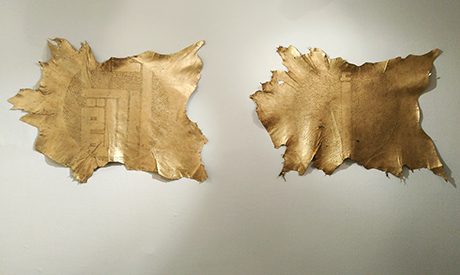
Artwork by Chadi Adib Salama (Photo: Soha Elsirgany)
For some pieces the shape of the hide is left organically irregular, but the material itself is, in contrast, heavily worked with Arabic calligraphy and lettering – a mixture of large text that can be read from a distance, and smaller text to be seen up close.
One of the irregularly shaped pieces reads in large Kufic letters the word Eqraa (Read), the first word the Prophet Mohammad received from God in the Quran’s text. The word is a nod to reading’s direct relationship with knowledge, and evokes a spiritual value alongside the material value of the gold leather.
Displayed on one of the walls are leather pieces cut in circles, also similarly adorned with text, but in those the artist layered some parts with additional leather pieces, making the overall texture uneven and intentionally unrefined.
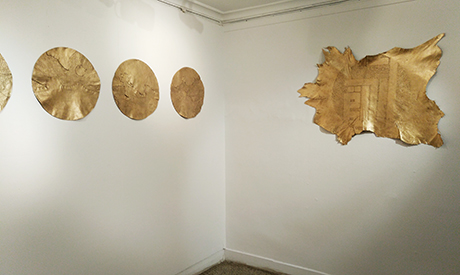
Artwork by Chadi Adib Salama (Photo: Soha Elsirgany)
The work of Tamer Shahin takes up the next hall, with his digital photography project Fi Hadret Mawlana (In the Presence of Mawlana).
The photographs depict scenes of people at a moulid (festival) for Zein Al-Abidin.
Zayn Al-Abidin is the name of Ali Ibn Al-Husayn, also known as the Fourth Imam, a descendant of the Prophet Mohammad who to this day is celebrated within both Shia and Sufi circles, and has around four texts on asceticism and religious practice attributed to him.
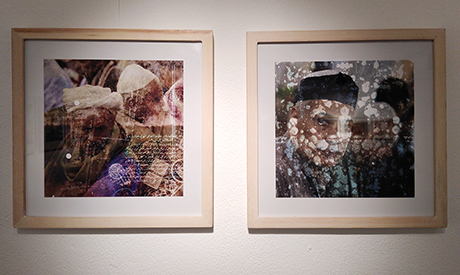
Artwork by Tamer Shahin (Photo: Soha Elsirgany)
Shahin has written some words to accompany the images, citing a conversation with a woman he met at the moulid whom, he discovers, works as a house-cleaning lady but holds a doctoral degree in geology.
“All of us here are like this, regardless of our different background. From all governorates we come here to serve and I’m fully devoted to this now and have left behind me all the world’s burdens and problems and ask nothing from it,” the woman tells Shahin. He describes her and other moulid attendees as “answering the call to divine love.”
The images are intense, packed and layered. Text verses of prayers are superimposed over portraits of moulid attendees resulting in scenes as busy as the artist describes them in his text.
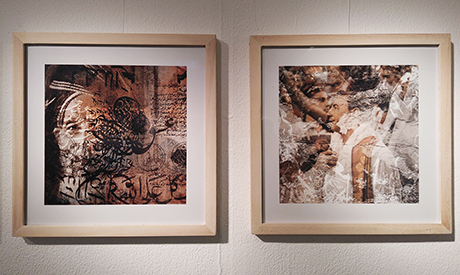
Artwork by Tamer Shahin (Photo: Soha Elsirgany)
Eight large photographic prints by Bassam Al-Zoghby are displayed in the centre's central hall.
Under the title Solo, Al-Zoghby visually explores the subject of loneliness.
“The feeling of loneliness is not related to sitting alone; it could be not being in tune with people around you, feeling disconnected or that everyone is distracted from you in their own world,” El-Zoghby tells Ahram Online.
“This project was about a more personal subject,” he tells Ahram Online.
“I can’t remember the first time I felt loneliness. I was young and only aware of the frustrating discomfort of this feeling … as the years went by, despite involvement in various social circles, this feeling still overcomes me,” Al-Zoghby writes in his description.
The works are thematically different than Al-Zoghby’s journalistic photos for Al-Ahram, for which he covers arts and culture events.
Yet visually, Al-Zoghby stays true to his love for capturing movement, which makes even his journalistic photographs artistic.
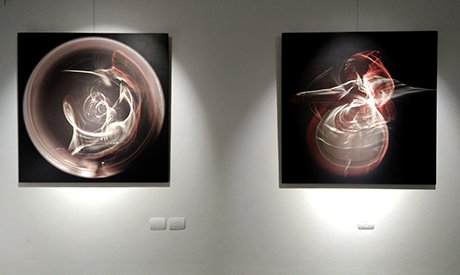
Artwork by Bassam Alzoghby (Photo: Soha Elsirgany)
In his previous exhibitions, Al-Zoghby’s colours were vibrant and not largely black.
All in black and white, with a flash of scarlet red, each frame contains a sole figure in twirling movements, captured with exaggerated motion through long exposure.
This time black is dominant, the figures appear to exist in a dark vacuum, or an empty stage, as if dancing when no one is looking, twirling in vigorous circles repeatedly, each self-contained in a frame, solo. The camera catches their sweeping body movements like a canvas catches paint from a brushstroke.
“I like to leave it open for people to interpret as they wish. But for me this movement could be someone trying to escape the loneliness, but who remains trapped – someone who is not at peace,” he says.
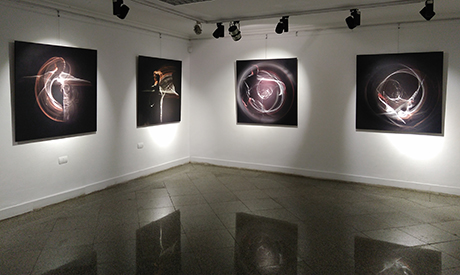
Artwork by Bassam Alzoghby (Photo: Soha Elsirgany)
In the last display hall, Tarek Radi’s pieces entail a different type of approach to what is intangible, with a body of drawings and hand prints titled 'Serendipity.'
Using print making on paper, his choice of medium is less complex than the other artists’ exhibiting in parallel at the centre.
Radi’s work can be seen as meditative, not through spirituality but in his long-term approach of comprehensively observing and dissecting scenes in Egyptian society.

Artwork by Tarek Radi (Photo: Soha Elsirgany)
“The works were produced as part of a long term project over the last two years, as a result of research, observation and experimentation on scenes and experiences in various environments,” Radi writes describing his project.
He captures social rhythm on paper, through abstracted figures and objects that float nowhere specific. His technique brings to mind children’s stamping exercise, but with more mature and deliberate compositions.
Looking at tens of his pieces lined up, the artist seems to have lost himself in his own world. It’s as if you can see him spending long quiet hours producing them from scenes in his memory.

Artwork by Tarek Radi (Photo: Soha Elsirgany)
Programme:
The exhibition opens on Tuesday, 6 December at 7pm, and will run until 19 December
Open from 10 am to 2 pm, and 5pm to 9pm daily, except Fridays.
Saad Zaghloul Cultural Centre, 2 Saad Zaghloul Street, El-Mounira, Cairo
For more arts and culture news and updates, follow Ahram Online Arts and Culture on Twitter at @AhramOnlineArts and on Facebook at Ahram Online: Arts & Culture
Short link: